Guest blogging by actor Tammy Batey. -Ed.
Quick costume changes are new to me. “The New New News” is my third play. In my first, I wore scrubs the entire time. For my second, I changed my costume once but had two long scenes in which to do so, enough time to not only change but also sit in the Green Room for more than an hour chatting with other actors awaiting their cues.
But in “The New New News,” I play five characters requiring five costumes and three of those characters are in back-to-back scenes. This means sequestering various articles of clothing just off stage where I can quickly change in the 30 seconds to a minute I have between those scenes.
One of the most exciting things about acting is you get to peek behind the curtain. Hell, you get to live behind the curtain for the duration of a performance. And the quarters can be tight. At South Seattle Community College, the play’s home this weekend, there’s not much room offstage and no entrance from stage right.
That means that between the very short stretch of time between exiting the stage as Elaine the photographer and re-emerging as Reporter 2, I am squeezed in a wee alcove of space on stage right that contains props and various actors’ costumes. I am shucking clothes like a mad woman and putting on my next costume beside a few actors either doing the same or awaiting their next cue.
Last night, I finished zipping up one of my boots a mere second before I walked to my place for the next scene. All the while I was changing, I was trying very hard – unfortunately, without much success – to not inadvertently elbow a fellow actor who was this close and also changing.
Because of the sometimes close quarters and brief time between scenes, actors must shuck their modesty as quickly as they doff their costumes. At some point and perhaps on many occasions, you will stand backstage in your underwear putting on your next costume. When there is no time to head to a dressing room, you have no option but to embrace your inner exhibitionist.
It helps that your fellow actors are so busy changing, re-reading their lines and awaiting their entrances that they’re not exactly gawking at you in your underwear. In fact, they can be a valuable help with those quick costume changes – the camaraderie among actors being one huge perk of acting. One of my costumes is bulky and challenging to move in. Last night, two actors were happy to help me with my shoes and hat when I couldn’t bend over far enough to lift them off the floor.
This weekend is opening weekend for “The New New News.” Let the quick-changing commence!






